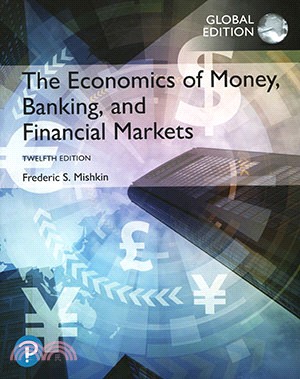The Economics of Money, Banking and Financial Markets strengthens students' application and decision-marking skills, and it does so with a focus on real-world examples. Easy-to-follow graphics, crisp definitions, and a thoroughly accessible text highlight the applications of economics, making them relatable through everyday examples and concerns.
New to This Edition
The twelfth edition provides more rigor and clarity through internationally relevant topics and example, including the following new sections, boxes, and applications:
Enliven students’study of money, banking, and financial markets
1. Chapter 1 teaches students about career opportunities available beyond Wall Street or in a bank.
2. Chapter 4 illustrates negative interest rates in countries like Japan, the United States, and Europe.
3. Chapter 5 shows how the supply and demand model explains current interest rate movements.
4. Chapter 12 discusses and analyzes how the financial crises that originated in the United States also impacts other advanced global economies.
5. Chapter 13 discusses the crisis-stricken Mexico, Thailand, and South Korea’s external debt and highlights the same using appropriate diagrams.
6. Chapter 14 highlights major banking systems around the world—the European Central Bank, the Federal Reserve, the Bank of Japan—their origins, structure, and functions.
7. Chapter 18 highlights an application on Burgernomics, Big Macs, and Purchasing Power Parity, as a fun way of showing students how purchasing power parity works in practice.
| FindBook |
有 1 項符合
The Economics of Money, Banking and Financial Markets(GE)(12版)的圖書 |
 |
The Economics of Money, Banking and Financial Markets (GE) 作者:Frederic Mishkin 出版社:華泰文化 出版日期:2019-04-01 語言:英文 規格:平裝 / 738頁 / 20.3 x 25.5 x 2.3 cm / 普通級/ 全彩印刷 / 12版 |
| 圖書館借閱 |
| 國家圖書館 | 全國圖書書目資訊網 | 國立公共資訊圖書館 | 電子書服務平台 | MetaCat 跨館整合查詢 |
| 臺北市立圖書館 | 新北市立圖書館 | 基隆市公共圖書館 | 桃園市立圖書館 | 新竹縣公共圖書館 |
| 苗栗縣立圖書館 | 臺中市立圖書館 | 彰化縣公共圖書館 | 南投縣文化局 | 雲林縣公共圖書館 |
| 嘉義縣圖書館 | 臺南市立圖書館 | 高雄市立圖書館 | 屏東縣公共圖書館 | 宜蘭縣公共圖書館 |
| 花蓮縣文化局 | 臺東縣文化處 |
|
|
圖書介紹 - 資料來源:博客來 評分:
圖書名稱:The Economics of Money, Banking and Financial Markets(GE)(12版)
內容簡介
目錄
PART I: INTRODUCTION
Ch 1 Why Study Money, Banking, and Financial Markets?
Ch 2 An Overview of the Financial System
Ch 3 What Is Money?
PART II: FINANCIAL MARKETS
Ch 4 The Meaning of Interest Rates
Ch 5 The Behavior of Interest Rates
Ch 6 The Risk and Term Structure of Interest Rates
Ch 7 The Stock Market, the Theory of Rational Expectations, and the Efficient Market Hypothesis
PART III: FINANCIAL INSTITUTIONS
Ch 8 An Economic Analysis of Financial Structure
Ch 9 Banking and the Management of Financial Institutions
Ch10 Economic Analysis of Financial Regulation
Ch11 Banking Industry: Structure and Competition
Ch12 Financial Crises in Advanced Economies
Ch13 Financial Crises in Emerging Economies
PART IV: CENTRAL BANKING AND THE CONDUCT OF MONETARY POLICY
Ch14 Central Banks
Ch15 The Money Supply Process
Ch16 Tools of Monetary Policy
Ch17 The Conduct of Monetary Policy: Strategy and Tactics
PART V: INTERNATIONAL FINANCE AND MONETARY POLICY
Ch18 The Foreign Exchange Market
Ch19 The International Financial System
PART VI: MONETARY THEORY
Ch20 Quantity Theory, Inflation, and the Demand for Money
Ch21 The IS Curve
Ch22 The Monetary Policy and Aggregate Demand Curves
Ch23 Aggregate Demand and Supply Analysis
Ch24 Monetary Policy Theory
Ch25 The Role of Expectations in Monetary Policy
Ch26 Transmission Mechanisms of Monetary Policy
Ch 1 Why Study Money, Banking, and Financial Markets?
Ch 2 An Overview of the Financial System
Ch 3 What Is Money?
PART II: FINANCIAL MARKETS
Ch 4 The Meaning of Interest Rates
Ch 5 The Behavior of Interest Rates
Ch 6 The Risk and Term Structure of Interest Rates
Ch 7 The Stock Market, the Theory of Rational Expectations, and the Efficient Market Hypothesis
PART III: FINANCIAL INSTITUTIONS
Ch 8 An Economic Analysis of Financial Structure
Ch 9 Banking and the Management of Financial Institutions
Ch10 Economic Analysis of Financial Regulation
Ch11 Banking Industry: Structure and Competition
Ch12 Financial Crises in Advanced Economies
Ch13 Financial Crises in Emerging Economies
PART IV: CENTRAL BANKING AND THE CONDUCT OF MONETARY POLICY
Ch14 Central Banks
Ch15 The Money Supply Process
Ch16 Tools of Monetary Policy
Ch17 The Conduct of Monetary Policy: Strategy and Tactics
PART V: INTERNATIONAL FINANCE AND MONETARY POLICY
Ch18 The Foreign Exchange Market
Ch19 The International Financial System
PART VI: MONETARY THEORY
Ch20 Quantity Theory, Inflation, and the Demand for Money
Ch21 The IS Curve
Ch22 The Monetary Policy and Aggregate Demand Curves
Ch23 Aggregate Demand and Supply Analysis
Ch24 Monetary Policy Theory
Ch25 The Role of Expectations in Monetary Policy
Ch26 Transmission Mechanisms of Monetary Policy
|










